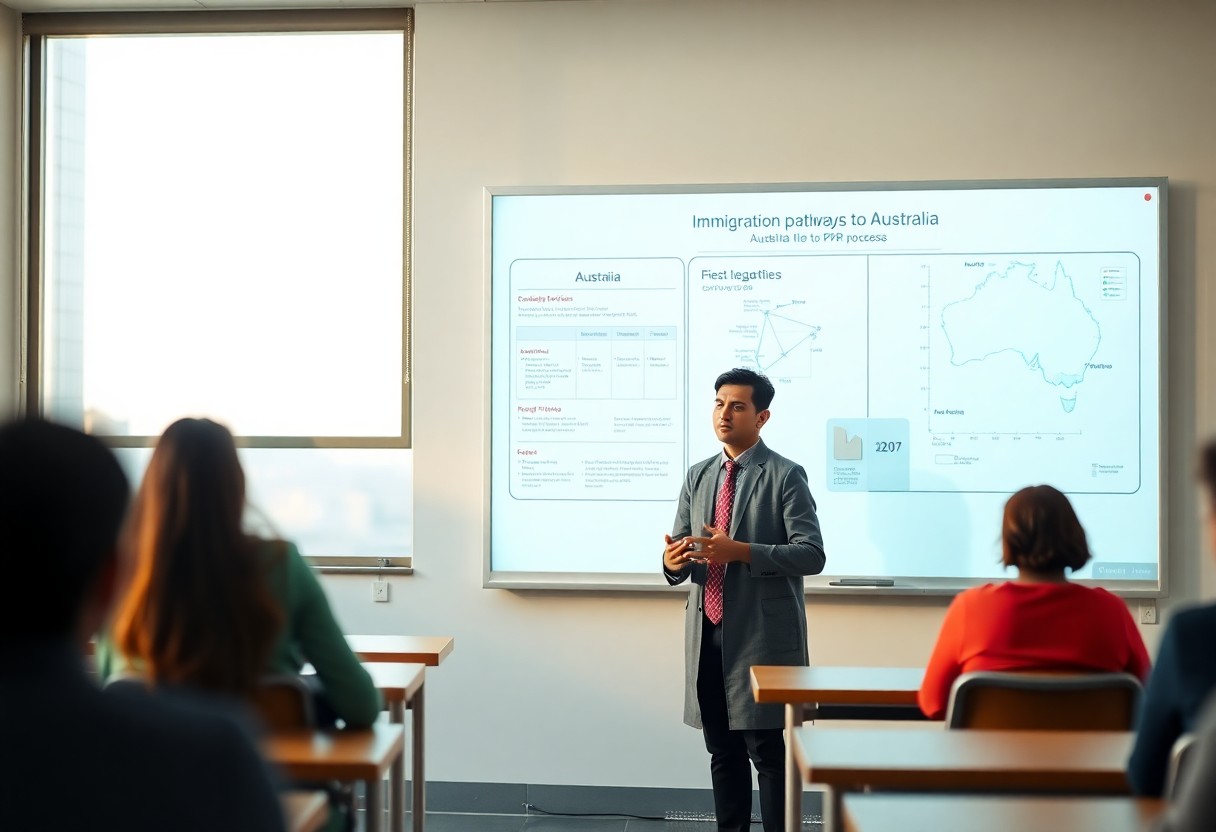Just by understanding the pathways available, you can maximize your chances to secure Permanent Residency (PR) in Australia as a teacher in 2025. This blog post will guide you through the imperative requirements, including necessary qualifications, skills assessments, and visa options specifically tailored for educators. As you navigate this process, being aware of key changes and trends can further enhance your prospects, ensuring you take the most effective steps toward your goal of a rewarding career in Australia.

Key Takeaways:
- Understand the Australian skilled migration program and relevant visa subclasses.
- Ensure qualifications meet Australian standards through assessment by designated authorities.
- Gain experience in teaching subjects in demand in Australia.
- Enhance English language proficiency, as it is required for migration and teaching roles.
- Consider state sponsorship options, which may offer additional pathways to PR.
- Stay updated on immigration policies and changes that may affect the application process.
- Network with other professionals and join relevant associations for resources and support.
The Australian Immigration Landscape for Teachers
The immigration landscape for teachers in Australia is evolving, with a growing emphasis on skill shortages in the education sector. Various states are actively seeking qualified educators to fill vacancies in both urban and regional areas, providing numerous opportunities for international teachers. Understanding the policies and demands specific to different Australian states can enhance your ability to secure a permanent residency path.
Reasons for Increased Demand in 2025
By 2025, Australia is expected to experience a significant rise in demand for teachers, driven by population growth and an emphasis on improving education standards. Factors such as the anticipated retirement of seasoned educators and the expansion of educational institutions further intensify the need for qualified professionals. This demand creates an advantageous environment for teachers looking to immigrate.
Key Visa Pathways Available for Educators
Several visa pathways are available for educators seeking to move to Australia, with the most common being the Skilled Independent Visa (subclass 189) and the Skilled Nominated Visa (subclass 190). Additionally, the Temporary Graduate Visa (subclass 485) allows recent graduates to gain work experience in their field before applying for permanent residency. Each pathway has specific eligibility criteria, making it important to ensure you meet the required qualifications and work experience.
The Skilled Independent Visa (subclass 189) is particularly beneficial, as it allows you to reside and work anywhere in Australia, granting flexibility and autonomy. This visa requires you to submit an Expression of Interest (EOI) and be invited based on your points score from factors such as age, education, and English proficiency. The Skilled Nominated Visa (subclass 190) requires nomination by a state or territory, often providing greater job security and pathways to permanent residency. Evaluating your options thoroughly ensures you select the most suitable visa to achieve your migration goals.

Navigating Educational Credential Assessment
Educational Credential Assessment (ECA) is a vital step for Indian teachers seeking PR in Australia. It verifies the authenticity and comparability of your qualifications to the Australian education system. Inaccurate assessments can lead to delays or denial of your application. Understanding each component of the ECA process allows you to present your credentials in the best possible light, ensuring that your qualifications align with Australian standards.
Steps for Documentation and Application
Begin your ECA by gathering all necessary documents, including academic transcripts, degree certificates, and proof of teaching experience. Authenticate these documents through authorized bodies and ensure they are translated into English if needed. Once organized, apply through a designated assessing authority like the Australian Institute for Teaching and School Leadership (AITSL). This process may take several weeks, so submit your application well in advance.
Common Pitfalls in Credential Validation
Many candidates face challenges during the credential validation process. Incomplete documentation often leads to delays, while errors in translations or mismatches in the names on records can result in denials. Additionally, failing to follow specific guidelines set by assessing authorities may hinder your chances for a successful assessment.
Inadequate consideration of the specific requirements set forth by each assessing body is a frequent oversight. For instance, not including a detailed syllabus or course descriptions alongside your transcripts can hinder the evaluation of your qualifications. Furthermore, variations in nomenclature between Indian and Australian educational systems can create confusion, so ensuring accuracy in terminology is crucial. Be conscious of not submitting outdated documents or missing deadlines, as both can severely impact your application result. Adopting a meticulous approach will help you avoid these common pitfalls and enhance your chances for a favorable outcome.
Strengthening Your Employability Profile
Enhancing your employability profile is important for securing a teaching position in Australia. Focus on obtaining relevant qualifications and accumulating experience that aligns with Australian educational standards. Engaging in professional development, complementing your CV with voluntary roles, and demonstrating cultural adaptability will make you a strong candidate in a competitive job market.
Essential Qualifications and Professional Development
Achieving important qualifications such as a recognized teaching degree, along with additional certifications specific to the Australian context, significantly enhances your profile. Participate in professional development workshops and training programs to stay updated with the latest pedagogical practices, ensuring your skills remain in line with expectations for Australian educators.
Strategic Networking within Australian Educational Circles
Building strategic connections within Australian educational circles will help you navigate the job market more effectively. Active participation in local educational events, conferences, and professional associations allows you to meet influential stakeholders, gain insights into hiring trends, and access job openings before they are publicly advertised.
Engagement with networks such as the Australian Council for Educational Leaders (ACEL) or Teachers Registration Board can provide valuable mentorship opportunities. Attend seminars and engage in discussions on platforms like LinkedIn to showcase your expertise while establishing relationships that could lead to job referrals. Volunteering in local schools or community initiatives further enhances your visibility, demonstrating your commitment to Australian education and enabling you to build a supportive network.
Understanding the Role of Sponsorships and Partnerships
Sponsorships and partnerships with Australian schools and educational institutions can significantly enhance your chances of obtaining a work visa and permanent residency. Many schools seek international teachers to address local staffing shortages, fostering opportunities for mutually beneficial arrangements. Engaging in these partnerships not only provides you with a pathway for employment but also offers cultural exchange and professional development experiences that can strengthen your profile as a prospective educator in Australia.
Identifying Potential Sponsoring Schools and Institutions
Researching schools and institutions in Australia that actively sponsor international teachers is vital. Look for areas with high demand for educators, particularly in regional locations where government incentives may exist to attract international talent. Websites like the Australian Government’s Department of Education can provide lists of designated schools and their sponsorship capabilities, helping you focus your job search effectively.
Building Relationships for Secured Employment Opportunities
Developing strong connections within the Australian education sector increases your likelihood of securing sponsorship. Networking through educational conferences, webinars, and social media platforms like LinkedIn can provide insight into school cultures and staffing needs. By connecting with current teachers and administrators, you can gain recommendations and insights that are invaluable in your pursuit of employment.
Your networking efforts should focus on creating genuine relationships that go beyond mere job searching. Consider reaching out to educators in your subject area to discuss teaching methodologies and share experiences. Participating in online forums dedicated to expatriate teachers can also lead to opportunities for mentorship. As you establish your presence, always be proactive—follow up on conversations and express your desire to contribute to their school community. These actions can help create a favorable impression, positioning you as a desirable candidate for future employment openings and potential sponsorships.

Strategic Application Timing and Preparation
Timing your PR application effectively can significantly impact your success. Staying aware of changes in immigration policies and trends in teacher demand can help you choose the optimal moment for submission. Aim to submit your application when your qualifications and experience align with Australia’s current needs, enhancing your chances of success.
Best Practices for Timing Your PR Application
Submit your PR application shortly after receiving positive results from your Educational Credential Assessment (ECA). Align your application with Australia’s occupation lists, focusing on periods when there is a higher demand for teachers, particularly in regional areas. Staying informed about government announcements can also give you a competitive edge.
Preparing for Potential Interviews and Assessments
Being prepared for interviews and assessments can significantly enhance your confidence and performance. Familiarize yourself with common interview questions specific to the teaching profession in Australia. Brush up on relevant teaching methodologies, curriculum frameworks, and Australian education standards to showcase your readiness and adaptability.
Developing a thorough understanding of the Australian education system and its expectations will help you articulate your teaching philosophy and experience. Practice answering typical behavioral and situational questions to demonstrate your problem-solving skills and teaching effectiveness. Engage in mock interviews with peers or mentors who understand the Australian context, and utilize their feedback to refine your responses. This preparation will position you as a strong candidate during the assessment phase of the PR process.
Summing up
With these considerations, you can enhance your chances of securing PR in Australia as a teacher in 2025. Ensure you meet the necessary qualifications and assessment requirements set by the Australian government. Actively seek opportunities to gain relevant work experience in Australia, as this can strengthen your application. Stay informed about immigration policies and changes in demand for teachers, and consider skilled occupation lists to identify the most favorable pathways. By strategically navigating these aspects, you position yourself favorably to achieve your goal of permanent residency.
FAQ
Q: What qualifications are required for Indian teachers to apply for PR in Australia in 2025?
A: Indian teachers must have a recognized teaching qualification, such as a bachelor’s or master’s degree in education. Additionally, they need to meet the English language proficiency requirements, typically through tests like IELTS or TOEFL.
Q: Is it necessary to have teaching experience to secure PR in Australia?
A: Yes, relevant teaching experience is generally required. Most PR pathways prefer candidates with at least 1-2 years of full-time teaching experience in their respective fields.
Q: Which Australian states offer PR opportunities for teachers?
A: Various states such as New South Wales, Victoria, Queensland, and Western Australia have specific programs targeting teachers. Each state has its own demand lists, so it’s vital to check the current situation for each state.
Q: How can Indian teachers get their qualifications assessed for PR?
A: Indian teachers must undergo a qualification assessment through an authorized assessing body, such as the Australian Institute for Teaching and School Leadership (AITSL), which verifies the equivalence of their qualifications.
Q: What visa types are available for teachers from India seeking PR in Australia?
A: Common visa types include the Skilled Independent Visa (subclass 189), the Skilled Nominated Visa (subclass 190), and the Teacher’s Visa (subclass 482). Each has specific requirements and pathways.
Q: How important is professional development for Indian teachers applying for PR?
A: Engaging in professional development is beneficial as it enhances teaching skills and may strengthen the PR application. Participation in workshops, conferences, and additional qualifications can make candidates more competitive.
Q: What are the English language requirements for Indian teachers applying for PR?
A: Indian teachers must demonstrate proficiency in English, typically requiring a minimum score of 7.0 in IELTS or equivalent in other English tests, depending on the visa subclass applied for.


